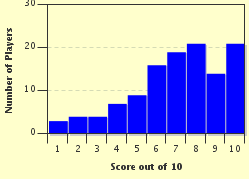Quiz Answer Key and Fun Facts
1. Perhaps one of the best known animal poems of all is Blake's 'The Tyger'. Which other animal is mentioned in these verses?
2. John Donne wrote about a small creature in a poem published in 1633. Which of these was it?
3. The owl and the pussycat make a rather unusual marriage in Edward Lear's poem. Who officiates at the wedding?
4. Thomas Gray wrote an ode to which animal, which met an untimely end in company with the creatures in the picture?
5. While perhaps better known for his novels, Thomas Hardy was also a prolific poet. He wrote about which type of bird, which he described as 'darkling'?
6. Oliver Wendell Holmes wrote an 1858 poem about which of these sea creatures?
7. Written by Marriott Edgar, and best known as a Stanley Holloway monologue, this rhyme describes the fate of Albert, eaten at Blackpool Zoo by which animal?
8. Which bird did Tennyson describe with the words 'like a thunderbolt he falls'?
9. Which animal was described by G K Chesterton as 'the devil's walking parody on all four-footed things'?
10. Robert Burns described which creature as a 'timorous beastie'?
Source: Author
rossian
This quiz was reviewed by FunTrivia editor
looney_tunes before going online.
Any errors found in FunTrivia content are routinely corrected through our feedback system.


